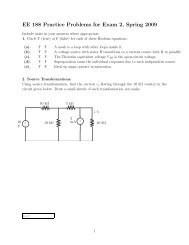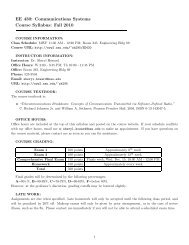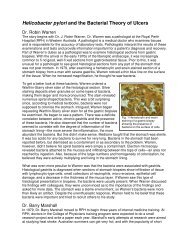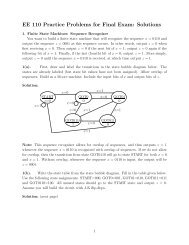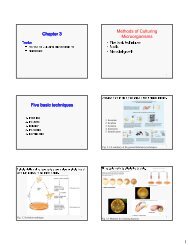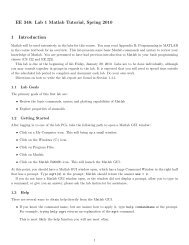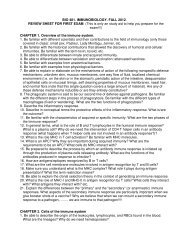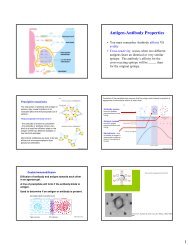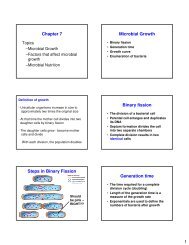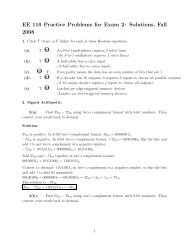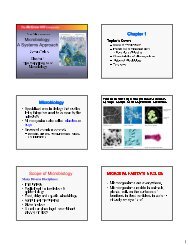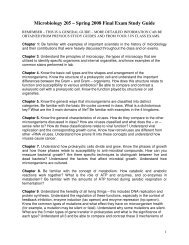SDS PAGE and Western blot
SDS PAGE and Western blot
SDS PAGE and Western blot
You also want an ePaper? Increase the reach of your titles
YUMPU automatically turns print PDFs into web optimized ePapers that Google loves.
<strong>SDS</strong> <strong>PAGE</strong> <strong>and</strong> <strong>Western</strong> <strong>blot</strong>1. Wipe down the spacer plates (spacers attached) <strong>and</strong> short plates (BioRad) with D.water,70%ethanol to remove any adherent material, dry <strong>and</strong> clamp them together.2. Solutions used:a. 1.5 M Tris-HCl, pH 8.8b. 0.5 M Tris-HCl, pH 6.8c. 30% acrylamide/bisacrylamided. N,N,N',N'-tetramethylethylene diamine (TEMED).This solution can be bought commercially <strong>and</strong> stored in fridge.e. 10% <strong>SDS</strong>Add 5.0 g <strong>SDS</strong> to a 100 ml bottleAdd 50 ml deionized waterf. 10% w/v ammonium persulfate, make fresh every month <strong>and</strong> store in fridge.g. Running buffer: Take 100 ml of stock (10X Tris glycine running buffer) <strong>and</strong> 900 ml ofDistilled water <strong>and</strong> make up to one liter.e. Sample buffer:100 mM Tris, pH 6.8,2% <strong>SDS</strong>,5% ß- mercaptoethanol,15% glycerol,3. Separating gel (add the following recipe)Percentage 14% 12% 10% 7.5%Total 40 ml 10 ml 5 ml 10 ml 5 ml 10 ml 5 mlD.Water 10.33 ml 3.35 ml 1.68 ml 4.0 ml 2.0 ml 4.85 ml 2.43 mlTris buffer (1.5M,pH 8.8)Acrylamide : Bisacrylamide10 ml 2.5 ml 1.25 ml 2.5 ml 1.2518.67 ml 4.0 ml 2.0 ml 3.33 ml 1.67mlml2.5 ml 1.25 ml2.5 ml 1.25 ml10% <strong>SDS</strong> 400 µl 100 µl 50 µl 100 µl 50 µl 100 µl 50 µl10% APS 200 µl 50 µl 25 µl 50 µl 25 µl 50 µl 25 µlTEMED 40 µl 15 µl 15 µl 15 µl 15 µl 15 µl 15 µl3. First add the add D.Water, Tris buffer, Acrylamide: Bis acrylamide solution <strong>and</strong> 10% <strong>SDS</strong>.
4. Add 10% ammonium persulfate <strong>and</strong> gently mix the solution.5. Add 15 µl of TEMED (stored in refrigerator), <strong>and</strong> gently invert to mix the gel componentsthoroughly (avoid introducing air bubbles as this can inhibit polymerization).6. Immediately pour the mix in between the plates. Fill the space up so there will be enoughroom to form a stacking gel of 0.5 to 1 cm.7. Overlay with 70% ethanol to a depth of a few millimeters.8. Allow the gel to polymerize for 20 minutes.9. After the running gel has polymerized, rinse the ethanol from the surface with D.water. Drainexcess water.10. Prepare the stacking gel. This is composed of 4% acrylamideStacking gel (add the following recipe)Percentage 4%Total 10 ml 5 mlD.Water 3.35 ml 1.68 mlTris buffer (0.5M, pH 6.8) 2.5 ml 1.25 mlAcrylamide : Bis acrylamide 4.0 ml 2.0 ml10%<strong>SDS</strong> 100 µl 50 µl10% APS 50 µl 25 µlTEMED 15 µl 15 µl11. Add the stocking gel mix. Insert appropriate combs.12. Polymerize stacking gel for 30 minutes.13. By the time prepare the protein. If the protein is already in solution, add an equal volumeof 2X sample buffer <strong>and</strong> boil in a boiling water bath for 5 min. Boil the markers if necessary(according the instructions by the company).14. Carefully remove comb (add some drops of running buffer in between well <strong>and</strong> combs to dothe job easy)
15. Rinse wells thoroughly with running buffer <strong>and</strong> assemble the gel in the electrophoresis rig.16. Pour running buffer in the top <strong>and</strong> bottom chambers,18. Load the samples in appropriate wells <strong>and</strong> add more running buffer in the top chamber20. Run the gel. Use a constant Amps power supply (80 mA). It will take approximately 1-2hours.21. Coomassie staining your gelCoomassie staina. Dissolve 2g Coomassie Blue R, 250 in 250ml waterb. Add 75ml of glacial acetic acid.c. Add 500ml of ethanold. make up to 1000ml with water22. Immerse gel for 1 hr in Coomassie.stain solution.23. Destain gelDistaining solutiona. Methanol -50%b. Acetic acid - 10%c. Distilled water -40%24. Immerse the stained gel into the destain solution Change the destain solution when itbecomes very blue.




